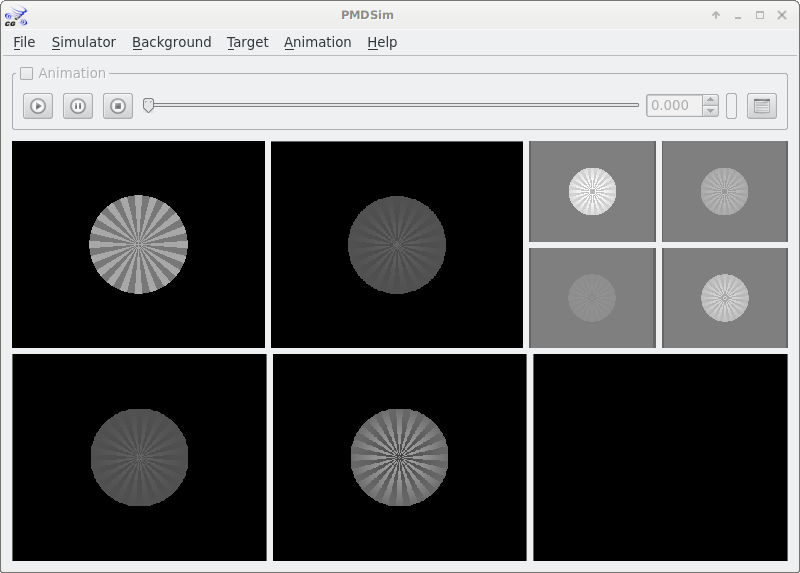This is a simulator for continuous-wave Time-of-Flight sensors, specifically PMD sensors.
It implements the illumination and sensor models described in this paper: M. Lambers, S. Hoberg, A. Kolb: Simulation of Time-of-Flight Sensors for Evaluation of Chip Layout Variants. In IEEE Sensors Journal, 15(7), 2015, pages 4019-4026.
This software was developed at the Computer Graphics Group, University of Siegen, in collaboration with pmdtec.
PMDSim is free software, licensed under the terms of the GNU GPL version 3 or later.
Please note that PMDSim is superseded by CamSim.
This software should build and run on any operating system. The build system is based on CMake. You need the following libraries:
- Qt version 4 (version 5 is not supported)
- GLEW
- OpenSceneGraph with the OSG/Qt module
If Doxygen is available, the HTML documentation will be generated as well.
Starting the program gives you this screen:
In the top left view, you see the current scene, consisting of a target (default: a Siemens star) and a background (default: nothing). You can use mouse and space bar to navigate within the scene. You can load different targets and backgrounds from OBJ files, or create predefined geometries, using the Target and Background menus.
In the top middle view, you see the Ground Truth range information. This is what an ideal camera would give you.
In the top right view, you see the four phase images that the simulated PMD sensor produces for the scene. You can change simulation parameters from the Simulator menu.
In the bottom row, you see the simulated results: range image (left), amplitude image (middle), and intensity image (right). Depending on simulation parameters, the range image shows the typical errors (flying pixels, motion artefacts, ...).
The scene is static by default, but you can animate it, either by using the mouse in the top left view to generate motion in the scene, or by loading an animation file from the Animation menu.
You can export the current frame or all frames of the current animation from the File menu. For each frame, you get the following files:
- Ideal depth for phase images 0, 1, 2, 3:
raw-depth-*.csv - Ideal energy that reaches each PMD pixel for phase images 0, 1, 2, 3:
raw-energy-*.csv - Simulated phase images 0, 1, 2, 3, A tap and B tap:
sim-phase-a-*.csvandsim-phase-b-*.csv - Simulated depth, amplitude, and intensity:
sim-depth.csv,sim-amplitude.csv,sim-intensity.csv
The pmdsim executable supports the following command line options
for automated tests and evaluations:
--simulator=FILE.TXT: load a simulator specification--background=FILE.TXT: load a background specification--target=FILE.TXT: load a target specification--animation=FILE.TXT: load an animation specification--export-dir=DIR: export file to the given directory--export-animation: export all frames of the animation and quit--export-frame=TIMESTAMP: export the frame nearest to the given timestamp (in seconds) and quit--minimize: start with minimized window and without progress dialogues.
